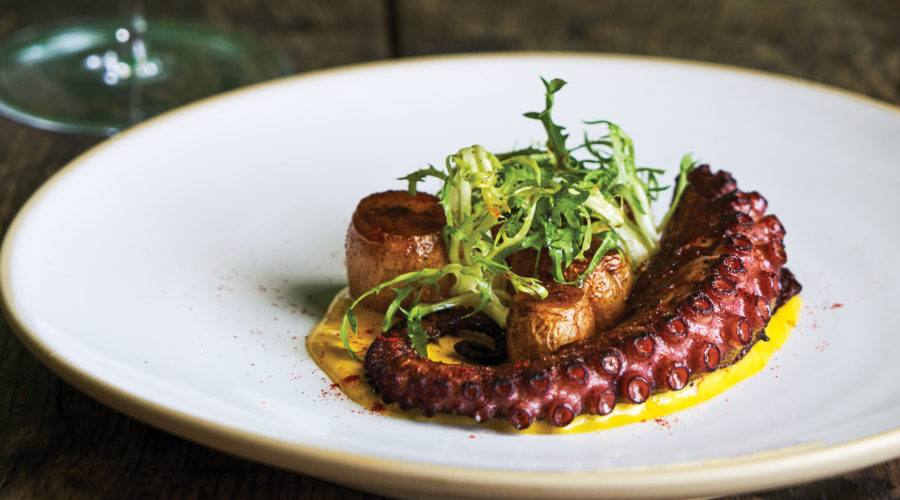Spanish Octopus, Fingerling Potatoes, Saffron Aioli & Frisée

“This is a classic dish that has been served in Spain and the rest of the world for years,” says Mathews. “The combination is not new to anyone, but when it is prepared with great attention to detail and perfectly cooked octopus, the result is extraordinary.”
This recipe, and others like it, can be found in the article "New Year’s Eve Wine Pairings: Bubbles and Dishes to Impress Your Friends."
How to Make It
Cook the octopus: Fill a large pot with 4 quarts water, carrot, onion, celery, and peppercorns. Bring to a boil, then reduce to a bare simmer.
Grab the octopus by the head, slowly lower its tentacles into the pot, then lift the tentacles out of the water completely. Repeat this process 4 more times. When the tentacles curl, gently lower the octopus until it is completely submerged. Cook the octopus on very low heat—the pot should be just wafting steam, not even a simmer.
After about 45 minutes, check the tenderness of the tentacles with a toothpick. You should be able to slide the toothpick through the center very easily. If you feel resistance, continue to cook, up to an hour or so. Once you can slide the toothpick into the tentacle, turn off the heat.
Transfer the octopus onto a sheet pan and let cool completely. Cut the tentacles off the body, keeping them whole. Be mindful of the beak in the center. Set aside.
To make the aioli, first make the garlic confit. In a medium pot, add garlic cloves and completely cover with oil (about 1 cup). Cook on low heat until the garlic is soft enough to crush with a spoon. Set aside to cool, then strain off the oil and reserve.
In a food processor, combine egg yolks, garlic confit, juice of 1 lemon, and salt. Turn on the food processor, and slowly drizzle in the reserved garlic oil and the remaining 1 cup of oil. The texture should be similar to mayo. Transfer aioli to a mixing bowl.
Add the saffron to the remaining lemon juice and let it steep for 5 minutes. Stir the saffron and lemon juice vigorously into the aioli—it will turn bright yellow.
Make the potatoes: Cut the tips off the potatoes so they will sit upright on a sheet pan. In a medium mixing bowl, mix potatoes, butter, paprika, and salt with your hands, making sure the potatoes are well-coated.
Preheat oven to 375°F. Stand the potatoes up on the pan and bake for 16 minutes, rotating the pan after 8 minutes. The potatoes should be fork tender.
Save the pan drippings to use as a vinaigrette for the frisée.
Set a cast-iron pan over high heat, and add the clarified butter. When it’s shimmering, sear the octopus tentacles. When they have a nice brown color and crispy skin, remove them and add the potatoes to the same pan to brown; when one end is brown, flip to brown the other. Meanwhile, in a small mixing bowl dress your frisée with lemon juice and a little of the pan drippings. In the center of your plate add a dollop of aioli, using the back of a spoon smooth the aioli into a small circle. Place the octopus tentacle on the aioli, add 5 fingerling potatoes right next to the octopus in the aioli. Garnish with the frisée on top of the potatoes and octopus, and finish with flaky sea salt. Repeat for each guest.

